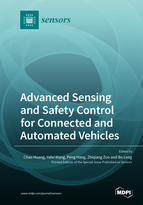Advanced Sensing and Safety Control for Connected and Automated Vehicles
A special issue of Sensors (ISSN 1424-8220). This special issue belongs to the section "Physical Sensors".
Deadline for manuscript submissions: closed (20 November 2022) | Viewed by 26927
Special Issue Editors
Interests: human–machine collaborative control; decision making; path planning; fault-tolerant control with the application of automated vehicles
Special Issues, Collections and Topics in MDPI journals
Interests: vehicle dynamics and control; connected and automated vehicles
Special Issues, Collections and Topics in MDPI journals
Interests: decision-making; autonomous driving; game theory; path tracking and control
Special Issues, Collections and Topics in MDPI journals
Interests: autonomous driving; network security and privacy protection; complex networks and multi-agent systems; robust control; antenna servo system control
Special Issues, Collections and Topics in MDPI journals
Interests: vehicle state estimation; dynamics control for autonomous vehicles
Special Issues, Collections and Topics in MDPI journals
Special Issue Information
Dear Colleagues,
Connected and automated vehicle (CAV) is a transformative technology that is expected to change and improve the safety and efficiency of the mobilities. As main functional components of CAVs, advanced sensing technologies and control algorithms, which gather environmental information, process data, and control vehicle motion, are of great importance. The development of novel sensing technologies for CAVs has become a hot spot in recent years. Thanks to the improved sensing technologies, CAVs are able to interpret sensory information to further detect obstacles, localize their positions, and navigate themselves and interact with other surrounding vehicles in the dynamic environment. Further, leveraging computer vision and other sensing methods, in-cabin humans’ body activities, facial emotions, and even their mental states can also be recognized.
The objective of this Special Issue is to compile recent research and development efforts contributing to advances in sensing and control for CAVs. The Special Issue will also welcome contributions addressing the state-of-the-art in associated developments and methodologies, and the perspectives on future developments and applications. The topics of interest within the scope of this Special Section include (but are not limited to) the following:
- Sensing technologies for environment perception of CAVs;
- Sensing technologies for localization and navigation of CAVs;
- Sensor fusion and signal processing in CAVs;
- Sensing for human behavior recognition in CAVs;
- Advanced control algorithms for CAVs;
- Control-oriented modeling for CAVs;
- Decision making, path planning, and tracking of CAVs;
- Human–automation collaboration for CAVs;
- Sensing, control, and testing for safety and security of CAVs;
- Emergency obstacle avoidance control of CAVs;
- Eco-driving control of CAVs;
- Active steering control of CAVs;
- Fault diagnosis and fault-tolerant control of CAVs;
- Sensing and control for multimodal vehicles (e.g., ground, aerial, underwater).
Dr. Chao Huang
Dr. Yafei Wang
Dr. Peng Hang
Prof. Dr. Zhiqiang Zuo
Dr. Bo Leng
Guest Editors
Manuscript Submission Information
Manuscripts should be submitted online at www.mdpi.com by registering and logging in to this website. Once you are registered, click here to go to the submission form. Manuscripts can be submitted until the deadline. All submissions that pass pre-check are peer-reviewed. Accepted papers will be published continuously in the journal (as soon as accepted) and will be listed together on the special issue website. Research articles, review articles as well as short communications are invited. For planned papers, a title and short abstract (about 100 words) can be sent to the Editorial Office for announcement on this website.
Submitted manuscripts should not have been published previously, nor be under consideration for publication elsewhere (except conference proceedings papers). All manuscripts are thoroughly refereed through a single-blind peer-review process. A guide for authors and other relevant information for submission of manuscripts is available on the Instructions for Authors page. Sensors is an international peer-reviewed open access semimonthly journal published by MDPI.
Please visit the Instructions for Authors page before submitting a manuscript. The Article Processing Charge (APC) for publication in this open access journal is 2600 CHF (Swiss Francs). Submitted papers should be well formatted and use good English. Authors may use MDPI's English editing service prior to publication or during author revisions.
Keywords
- connected and automated vehicle (CAV)
- sensing technologies
- advanced control algorithms
- decision making, path planning, and tracking
- human-machine collaboration
- emergency obstacle avoidance control, fault diagnosis and fault-tolerant control










